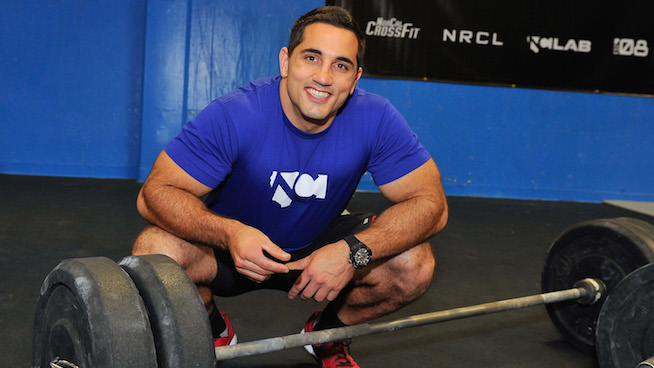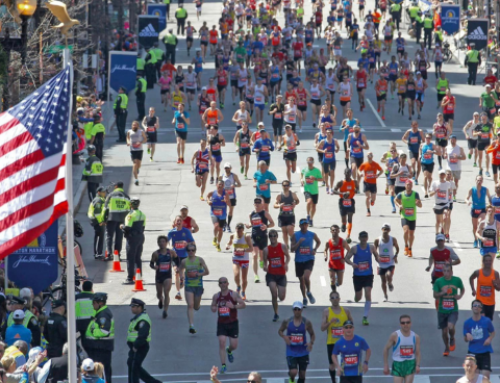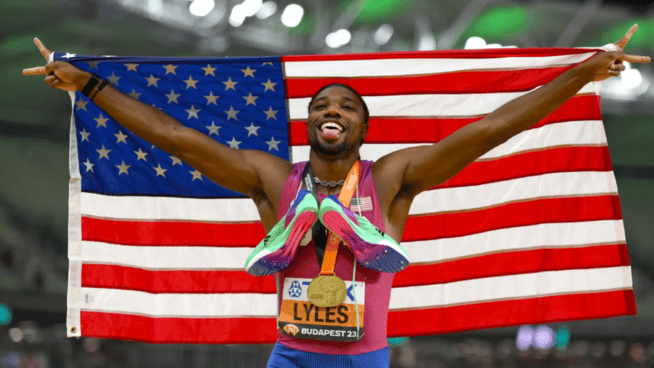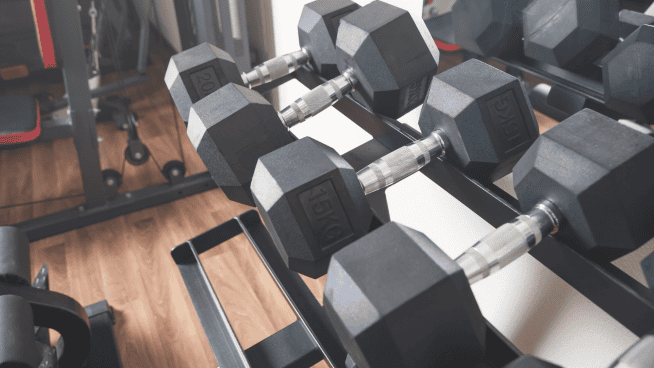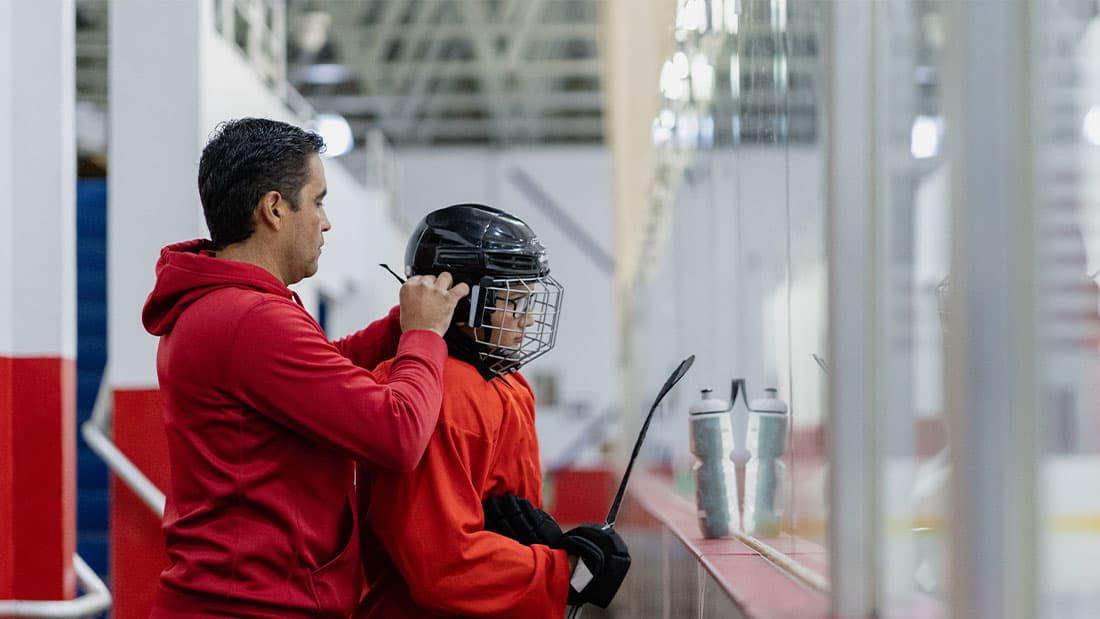Former CrossFit Champion Jason Khalipa Shares Secrets of His Success
Three-time Team USA CrossFit member, 2008 CrossFit champion with six Top-10 finishes, Jason Khalipa just competed in his eighth CrossFit Games.
Perhaps even more than for his 2008 title, Khalipa is known for his 2009 comeback. During the opening 7.1-mile run, he went so hard that he collapsed on the course several times, finishing 72nd out of 74 competitors. He came back to win the next event (the Deadlift) and place second in the following three events, finishing the Games in 5th place overall.
Beginning his career in 2006, Khalipa now owns and manages 20 CrossFit boxes, thorough his Bay Area company, NorCal CrossFit.
We recently spoke with Khalipa about his training regimen, his outlook on Paleo nutrition, CrossFit misconceptions, and his physical, mental, and professional CrossFit journey.
STACK: How did you first get into CrossFit?
Khalipa: I was introduced to CrossFit in 2006 by a buddy of mine. I used to work at a conventional gym, like a 24-Hour Fitness kind of thing. At the time I was looking for something new, and I wanted to make my workouts more fun and at the same time get quicker results. After I started, it took a couple months for me to fully understand what it was all about, and then I fell in love with it.
RELATED: An Orthopedic Surgeon’s Perspective on CrossFit
So you were a trainer before you began CrossFit?
Throughout college, I worked at the front desk. Then I worked in the sales department selling gym memberships. After awhile I realized I didn’t want to continue, because I felt people often weren’t getting the results that they wanted.
Once I realized CrossFit truly delivers results, I knew that’s what I wanted to do for the rest of my life. I haven’t looked back since.
What had you heard about CrossFit going in, and how did your initial experience compare to any expectations you may have had?
Ten years ago, it wasn’t as popular as it is today. I didn’t have any preconceived notions about it. A friend was just like, “hey, come try this workout,” and that’s what I did.
Did you play sports as a kid? If so, what did you bring with you from that, and how did CrossFit change your conception of training—or even of being on a team?
CrossFit is all about community. And for me, that team aspect was critical, because I had missed that community atmosphere. That group setting is fun, it’s exciting. Just being in a regular gym, pumping iron by yourself kind of gets old after awhile.
RELATED: What Happened When a 300-Pound Chain-Smoker Tried CrossFit
What were your personal gains like at the beginning, physically and mentally?
CrossFit has by far gotten me in the best shape of my life, far more so than I ever was doing conventional bodybuilding stuff. No ifs ands or buts about it. I could run faster, I could lift heavier, I was more flexible than I had ever been. It’s a combination of all those things.
The other day, I ran a 5:40 mile and then I snatched 290 pounds and deadlifted 550 pounds. Those numbers aren’t that crazy in the world of CrossFit, but, you know, it’s just kind of crazy to think about how many people in CrossFit are setting new standards.
People think they can only be good at so many things, running or lifting, swimming or biking, but the reality is we can be good at everything if we spend time training those different modalities.
Since you’ve been doing CrossFit, have you sustained any injuries?
No. CrossFit is significantly safer than people think. My gym takes 2,500 people a day through workouts. We have more people getting injured lifting at home than we do in our gym doing CrossFit.
RELATED: CrossFit’s Injury Rates Revealed
Speaking of working out in garages, do you have anything in particular right now that you’re using when you train at home?
Actually, Dollamur and I recently made a mat called the CrossFit ‘Go!’ Mat. It’s really kick-ass, because you can roll it out at your house and not have to worry about sweating all over the carpet. Working out on the carpet is gross, and working out on tile or wood is uncomfortable.
It’s kind of like a yoga mat, only thicker, so it gives you a little bit more cushion when doing certain types of exercise. I use it for stretching, but mostly I use it for things like Push-Ups, Sit-Ups and Burpees.
When you or your clients experience a plateau in training, what do you recommend to get past it?
Most of the time, when plateaus occur, it has to do with nutrition. When it comes to weight loss or weight gain, I tell my clients to start looking at what they’re eating.
In terms of fitness, however, most of our clients just don’t plateau. CrossFit is so varied that you’re hitting the body in so many different ways that, generally speaking, people are always progressing.
Can you describe a typical day for you when it comes to eating?
It’s just mainly old school, you know? Meat, vegetables, nuts. Really simple food. Right now, as we speak, I have a scramble next to me with a ton of vegetables.
If it comes in a box and has a ton of different ingredients in it, I probably won’t be eating it.
RELATED: 4 Lessons From CrossFit Master Greg Amundson
About how many meals per day?
I typically don’t eat huge meals, just moderate snacks. Throughout the day I’m not really hungry, and I’m never too full. Just satisfied. This way, I can work out throughout the day and it’s not a big deal. I don’t feel sluggish.
I eat nuts and different types of snacks throughout the day, and at night I’ll have a bigger dinner for sure—whatever my wife cooks. In general, it’s going to be something like more Paleo style, mainly meat and a good blend of vegetables.
How strictly do you adhere to the Paleo diet?
I wouldn’t say I’m 100 percent Paleo at all. I eat brownies, cake or muffins if I feel like it. But for the most part, I eat clean, you know?
Can you walk us through a typical day for you training-wise?
Every day is different. Every day I split it into two sessions—weightlifting and cardio. Or I’ll do a weightlifting or endurance-based session by itself and then a purely CrossFit workout, where it’s a blend of gymnastics, lifting and cardio-type stuff.
Do you have a warm-up routine?
Not really. My warm-ups are always different. I prep my body based on what I’m getting into that day. So if I’m snatching, I’ll prep for snatching, and so forth. It really depends on what I’m doing that day.
Could you give us an example? Lets say you’re snatching or squatting. Would you warm up with bodyweight squats?
If I’m squatting heavy, the goal is to get that range of motion dialed in, get a little sweaty and then slowly progress my way up.
Do you have any favorite exercises?
Good question. The movements . . . well, I like them all. Handstand Walk, Snatch, Clean and Jerk, Box Jump, Pull-Up. I guess you could say my favorite exercise is the one I didn’t do the day before. It’s about varying everything you do and just having fun with it, which is why CrossFit is great—because no two days are exactly the same.
What was the most challenging exercise for you starting off?
Probably Pistol Squats.
Yeah, those are brutal. How much do you work on flexibility?
A lot, because we incorporate that in our dynamic warm-up, working on range of motion. Often, a lot of people who just do bodybuilding type stuff have terrible range of motion, specifically in their shoulders. So for them, over time, they could gain a lot from prepping that area and opening up their chest and shoulders.
That’s somewhat surprising. Generally speaking, the shoulder is the most mobile joint in the body.
Sure, ankles and hips, for example, cause issues. But from what I’ve seen, for a lot of people who come from a conventional gym background with really built-up chests, their upper shoulders are locked. If you’re trying to get them to do an Overhead Squat, their shoulders have really crappy mobility, and they have a hard time getting into a front rack position and into an overhead position.
Let’s talk about you competing this summer in your 8th CrossFit Games. Did you approach these games differently from in the past, either in method or mentality?
For seven years, I’ve competed as an individual, and this year I competed on a team.
Which means that the type of training is totally different than the things you’re required to do as an individual. This year, I based my training towards a team style—more interval-based, as well as partner-based.
Do you have a benchmarking process that you go through week by week? How do you generally track your progress?
I mean, I know myself, I know how I feel during workouts, I know if my number is going in the right direction.
How would you describe the relationship between training and competing? What skills do you need to compete effectively?
Well, first off you have to love to train in order to compete well. If you don’t love to train, you’re not going to put in enough work to compete well. So that’s number one.
Then, assuming you love to train, you can’t just be good in your garage. You have to be good when it matters. And there are plenty of people who put up videos of themselves doing something in their garage, but can’t necessarily perform the exercise when it matters.
Performing in front of a bunch of people requires skills that you need to develop over time, and it starts with loving to train. Because you can’t mimic the stress or dynamic of competition until you actually do it. You need to compete in order to get better at competing.
Have you ever given advice to your teammates or trainees and found it difficult to follow yourself?
No. I definitely practice what I preach. I’ve competed in more big competitions than probably any other CrossFitter. The more you compete, the more you learn about yourself and how you react in those situations.
Is there a particular Games that stands out in your mind, either above the rest or below the rest?
Not really. I mean, obviously, I’ve won the CrossFit Games, and that was pretty great. I’ve come back from not doing so well and I’ve come back to get on the podium. So I can’t say one year is better than the rest.
Fortunately for me, a lot of the big competitions have ended up really well. I’ve had more good years and fun experiences than I’ve had negative, but the negative experiences have helped to shape my good experiences.
Can you name a negative experience that you learned something from?
Not necessarily an entire Games, but I’ve had events where I overreacted or wasn’t composed. And then I didn’t perform well.
Was there a moment when you started out when you knew CrossFit would be more than just a workout for you?
I never thought about it like that, as a profession or from a competing standpoint. I competed because I love to compete, not because of the money or fame or anything.
And I started coaching people because I believed in the program. Now, we probably have the largest gym in the CrossFit world. It started off as just me and 1,000 square feet, just training people. It grew and grew, and now we have about 20 locations worldwide.
As an instructor, what do you learn from your students? Or how has being an instructor shaped you as an athlete?
I love sharing my passion with the athletes in the gym. That’s the best way to describe it. I just have a lot of fun doing it.
What would you say to the CrossFit naysayers? Or, what’s your best advice to young athletes who are trying to succeed and find motivation from within?
CrossFit is one of those sports where you can’t just wake up tomorrow and think you’re going to be able to go to the CrossFit Games. But it’s really important to have fun with it. A lot of people take CrossFit too seriously. They just need to relax. If you don’t take the time to enjoy the experience, there’s a good chance you’ll get burned out and never get to the next level.
RECOMMENDED FOR YOU
MOST POPULAR
Former CrossFit Champion Jason Khalipa Shares Secrets of His Success
Three-time Team USA CrossFit member, 2008 CrossFit champion with six Top-10 finishes, Jason Khalipa just competed in his eighth CrossFit Games.
Perhaps even more than for his 2008 title, Khalipa is known for his 2009 comeback. During the opening 7.1-mile run, he went so hard that he collapsed on the course several times, finishing 72nd out of 74 competitors. He came back to win the next event (the Deadlift) and place second in the following three events, finishing the Games in 5th place overall.
Beginning his career in 2006, Khalipa now owns and manages 20 CrossFit boxes, thorough his Bay Area company, NorCal CrossFit.
We recently spoke with Khalipa about his training regimen, his outlook on Paleo nutrition, CrossFit misconceptions, and his physical, mental, and professional CrossFit journey.
STACK: How did you first get into CrossFit?
Khalipa: I was introduced to CrossFit in 2006 by a buddy of mine. I used to work at a conventional gym, like a 24-Hour Fitness kind of thing. At the time I was looking for something new, and I wanted to make my workouts more fun and at the same time get quicker results. After I started, it took a couple months for me to fully understand what it was all about, and then I fell in love with it.
RELATED: An Orthopedic Surgeon’s Perspective on CrossFit
So you were a trainer before you began CrossFit?
Throughout college, I worked at the front desk. Then I worked in the sales department selling gym memberships. After awhile I realized I didn’t want to continue, because I felt people often weren’t getting the results that they wanted.
Once I realized CrossFit truly delivers results, I knew that’s what I wanted to do for the rest of my life. I haven’t looked back since.
What had you heard about CrossFit going in, and how did your initial experience compare to any expectations you may have had?
Ten years ago, it wasn’t as popular as it is today. I didn’t have any preconceived notions about it. A friend was just like, “hey, come try this workout,” and that’s what I did.
Did you play sports as a kid? If so, what did you bring with you from that, and how did CrossFit change your conception of training—or even of being on a team?
CrossFit is all about community. And for me, that team aspect was critical, because I had missed that community atmosphere. That group setting is fun, it’s exciting. Just being in a regular gym, pumping iron by yourself kind of gets old after awhile.
RELATED: What Happened When a 300-Pound Chain-Smoker Tried CrossFit
What were your personal gains like at the beginning, physically and mentally?
CrossFit has by far gotten me in the best shape of my life, far more so than I ever was doing conventional bodybuilding stuff. No ifs ands or buts about it. I could run faster, I could lift heavier, I was more flexible than I had ever been. It’s a combination of all those things.
The other day, I ran a 5:40 mile and then I snatched 290 pounds and deadlifted 550 pounds. Those numbers aren’t that crazy in the world of CrossFit, but, you know, it’s just kind of crazy to think about how many people in CrossFit are setting new standards.
People think they can only be good at so many things, running or lifting, swimming or biking, but the reality is we can be good at everything if we spend time training those different modalities.
Since you’ve been doing CrossFit, have you sustained any injuries?
No. CrossFit is significantly safer than people think. My gym takes 2,500 people a day through workouts. We have more people getting injured lifting at home than we do in our gym doing CrossFit.
RELATED: CrossFit’s Injury Rates Revealed
Speaking of working out in garages, do you have anything in particular right now that you’re using when you train at home?
Actually, Dollamur and I recently made a mat called the CrossFit ‘Go!’ Mat. It’s really kick-ass, because you can roll it out at your house and not have to worry about sweating all over the carpet. Working out on the carpet is gross, and working out on tile or wood is uncomfortable.
It’s kind of like a yoga mat, only thicker, so it gives you a little bit more cushion when doing certain types of exercise. I use it for stretching, but mostly I use it for things like Push-Ups, Sit-Ups and Burpees.
When you or your clients experience a plateau in training, what do you recommend to get past it?
Most of the time, when plateaus occur, it has to do with nutrition. When it comes to weight loss or weight gain, I tell my clients to start looking at what they’re eating.
In terms of fitness, however, most of our clients just don’t plateau. CrossFit is so varied that you’re hitting the body in so many different ways that, generally speaking, people are always progressing.
Can you describe a typical day for you when it comes to eating?
It’s just mainly old school, you know? Meat, vegetables, nuts. Really simple food. Right now, as we speak, I have a scramble next to me with a ton of vegetables.
If it comes in a box and has a ton of different ingredients in it, I probably won’t be eating it.
RELATED: 4 Lessons From CrossFit Master Greg Amundson
About how many meals per day?
I typically don’t eat huge meals, just moderate snacks. Throughout the day I’m not really hungry, and I’m never too full. Just satisfied. This way, I can work out throughout the day and it’s not a big deal. I don’t feel sluggish.
I eat nuts and different types of snacks throughout the day, and at night I’ll have a bigger dinner for sure—whatever my wife cooks. In general, it’s going to be something like more Paleo style, mainly meat and a good blend of vegetables.
How strictly do you adhere to the Paleo diet?
I wouldn’t say I’m 100 percent Paleo at all. I eat brownies, cake or muffins if I feel like it. But for the most part, I eat clean, you know?
Can you walk us through a typical day for you training-wise?
Every day is different. Every day I split it into two sessions—weightlifting and cardio. Or I’ll do a weightlifting or endurance-based session by itself and then a purely CrossFit workout, where it’s a blend of gymnastics, lifting and cardio-type stuff.
Do you have a warm-up routine?
Not really. My warm-ups are always different. I prep my body based on what I’m getting into that day. So if I’m snatching, I’ll prep for snatching, and so forth. It really depends on what I’m doing that day.
Could you give us an example? Lets say you’re snatching or squatting. Would you warm up with bodyweight squats?
If I’m squatting heavy, the goal is to get that range of motion dialed in, get a little sweaty and then slowly progress my way up.
Do you have any favorite exercises?
Good question. The movements . . . well, I like them all. Handstand Walk, Snatch, Clean and Jerk, Box Jump, Pull-Up. I guess you could say my favorite exercise is the one I didn’t do the day before. It’s about varying everything you do and just having fun with it, which is why CrossFit is great—because no two days are exactly the same.
What was the most challenging exercise for you starting off?
Probably Pistol Squats.
Yeah, those are brutal. How much do you work on flexibility?
A lot, because we incorporate that in our dynamic warm-up, working on range of motion. Often, a lot of people who just do bodybuilding type stuff have terrible range of motion, specifically in their shoulders. So for them, over time, they could gain a lot from prepping that area and opening up their chest and shoulders.
That’s somewhat surprising. Generally speaking, the shoulder is the most mobile joint in the body.
Sure, ankles and hips, for example, cause issues. But from what I’ve seen, for a lot of people who come from a conventional gym background with really built-up chests, their upper shoulders are locked. If you’re trying to get them to do an Overhead Squat, their shoulders have really crappy mobility, and they have a hard time getting into a front rack position and into an overhead position.
Let’s talk about you competing this summer in your 8th CrossFit Games. Did you approach these games differently from in the past, either in method or mentality?
For seven years, I’ve competed as an individual, and this year I competed on a team.
Which means that the type of training is totally different than the things you’re required to do as an individual. This year, I based my training towards a team style—more interval-based, as well as partner-based.
Do you have a benchmarking process that you go through week by week? How do you generally track your progress?
I mean, I know myself, I know how I feel during workouts, I know if my number is going in the right direction.
How would you describe the relationship between training and competing? What skills do you need to compete effectively?
Well, first off you have to love to train in order to compete well. If you don’t love to train, you’re not going to put in enough work to compete well. So that’s number one.
Then, assuming you love to train, you can’t just be good in your garage. You have to be good when it matters. And there are plenty of people who put up videos of themselves doing something in their garage, but can’t necessarily perform the exercise when it matters.
Performing in front of a bunch of people requires skills that you need to develop over time, and it starts with loving to train. Because you can’t mimic the stress or dynamic of competition until you actually do it. You need to compete in order to get better at competing.
Have you ever given advice to your teammates or trainees and found it difficult to follow yourself?
No. I definitely practice what I preach. I’ve competed in more big competitions than probably any other CrossFitter. The more you compete, the more you learn about yourself and how you react in those situations.
Is there a particular Games that stands out in your mind, either above the rest or below the rest?
Not really. I mean, obviously, I’ve won the CrossFit Games, and that was pretty great. I’ve come back from not doing so well and I’ve come back to get on the podium. So I can’t say one year is better than the rest.
Fortunately for me, a lot of the big competitions have ended up really well. I’ve had more good years and fun experiences than I’ve had negative, but the negative experiences have helped to shape my good experiences.
Can you name a negative experience that you learned something from?
Not necessarily an entire Games, but I’ve had events where I overreacted or wasn’t composed. And then I didn’t perform well.
Was there a moment when you started out when you knew CrossFit would be more than just a workout for you?
I never thought about it like that, as a profession or from a competing standpoint. I competed because I love to compete, not because of the money or fame or anything.
And I started coaching people because I believed in the program. Now, we probably have the largest gym in the CrossFit world. It started off as just me and 1,000 square feet, just training people. It grew and grew, and now we have about 20 locations worldwide.
As an instructor, what do you learn from your students? Or how has being an instructor shaped you as an athlete?
I love sharing my passion with the athletes in the gym. That’s the best way to describe it. I just have a lot of fun doing it.
What would you say to the CrossFit naysayers? Or, what’s your best advice to young athletes who are trying to succeed and find motivation from within?
CrossFit is one of those sports where you can’t just wake up tomorrow and think you’re going to be able to go to the CrossFit Games. But it’s really important to have fun with it. A lot of people take CrossFit too seriously. They just need to relax. If you don’t take the time to enjoy the experience, there’s a good chance you’ll get burned out and never get to the next level.


